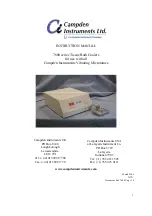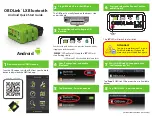
Page 23
© 2019 MSA
P/N 10203687
ENGLISH
ENGLISH
INSTRUCTIONS FOR USE
Do the steps in Figures 1A through 1C to don and adjust the harness. Adjust the back D-ring to put it in position between your shoulder blades (Figure 3). Make sure that the sternal and
dorsal connections are in the correct positions. Make sure that the free end of the adjusting strap extends at least 3 in. (8 cm) beyond the adjusting buckle. Put the free end of the webbing
in the keeper and below the thigh strap at the hip. Do NOT connect the right thigh strap to the left thigh, or vice versa. Make sure that the harness straps are not twisted and are flat against
the thighs. Make sure that the fit of the harness is tight. Make sure that all connectors are closed and locked before use. During use, regularly make sure that fastening and adjustment
elements are connected and adjusted correctly.
MSA full-body harnesses can include an integral D-ring extender. Make sure to include the length of the D-ring extender (shown on the product) in the calculation for free-fall distance
(Figure 8).
Do NOT use the harness in environments where the temperature is less than -40ºC or more than 50ºC. Frequently clean harnesses with Quick-Connect buckles that are used in dusty
environments. In dusty environments, small particles can collect and prevent correct operation of the buckle.
To monitor harness usage, MSA recommends that each harness be given to one specified user. Keep these instructions and the Individual Protective Equipment Record Card with the
harness.
MSA certifies that this product has been fully inspected and conforms to the full requirements and specifications of the standards indicated on the product. This product meets the
requirements of Regulation (EU) 2016/425 on personal protective equipment.
This harness is compliant with EN 361. Make sure that all components connected to the harness are compatible. MSA recommends that only approved MSA components be used with the
harness. For information about component compatibility, refer to EN 354 and EN 355 for the integral lanyard with energy absorber, and EN 358 for the work-positioning lanyard. Obey all
instructions and warnings for components used with the harness.
Not every full-body harness sold with these user instructions has all of the features shown. Identify which features are included with the product you purchased, and obey the applicable
instructions. The load capacity of the harness when used for fall arrest or rescue is 140 kg. The load capacity of the harness when used for restraint or work positioning is 150 kg.
WARNINGS
It is the user’s responsibility to know the contents of this manual and to get training before using the harness. Make sure that you have had sufficient training and fully know how to use the
harness safely. It is necessary for users to have good medical fitness to do work at a height. Some medical conditions can prevent safe use of the harness. In you have any doubt, consult
a physician before you use the harness. Children less than 18 years of age and pregnant women must NEVER use the harness.
Suspension intolerance, also referred to as suspension trauma or orthostatic intolerance, is a serious condition. Prompt rescue and the use of post fall suspension relief devices can help
to decrease the risk of suspension intolerance. The user must have a rescue plan and the equipment and specific training necessary to make the rescue as fast as possible under all
foreseeable conditions.
Use the harness only for its intended purpose and within its limitations. Obey the limits of the harness. Only use the integral lanyard with an energy absorber. If there is any doubt about the
condition of the harness for safe use, immediately remove the harness from service. A full-body harness is the only approved body-holding device that can be used in a fall-arrest system.
As specified by EN 353-1, EN 353-2, EN 355, and EN 360, a fall-arrest system must only be connected to the back D-ring or front loop with the fall-arrest marking “A” or “A/2”. Do NOT
use the hip D-ring or center back waist D-ring for fall arrest or climbing protection. Only use the center back waist D-ring for restraint. Only use the hip D-ring to connect a work-positioning
system (refer to EN 358). For work-positioning applications, always use both hip D-rings together, and use a separate fall-arrest system. Keep the anchorage point of the work-positioning
lanyard in position at or above waist level (Figures 7A and 7B). Make sure that tension on the lanyard is tight, and movement has a limit of 0.6 m.
To decrease the risk of pendulum (swing) falls, when possible, attach the fall-arrest system at an anchorage point directly above the user’s position (Figure 17). Use structural anchors
specified by EN 795 or anchorage points with a minimum strength of 12 kN.
The harness is intended to be worn during normal working activities. To make sure that the size, fit adjustment, and comfort level are correct for the intended use, MSA recommends that the
user do a suspension test in a safe area before using the harness in working conditions. Examine the harness before each use. Examine the harness straps for cuts, fraying, abrasion, too
much wear, changed or missing straps, burns, and exposure to ultraviolet, heat, or chemicals. Examine the stitching for pulled, loose, torn, or broken threads. Examine the legibility of the
product markings. Examine the hardware for deformation, cracks, corrosion, deep pitting, burrs, sharp edges, cuts, nicks, exposure to chemicals or too much heat, or other damage. Make
sure that both pawls on the buckle can engage and operate smoothly. If the harness shows any signs of damage, wear, or aging, immediately remove it from service.
A person who is competent in the examination of harnesses, other than the user, must do periodic examinations in accordance with MSA instructions.
Immediately remove damaged equipment from service and tag it “UNUSABLE”. For all corrective maintenance, such as the replacement of elements, contact MSA. Do NOT try to repair
equipment in the field.
To prevent collision with structures or the ground when a subsystem such as a lanyard or self-retracting lanyard is used, refer to the specific recommendations given with the subsystem.
Examine the fall-arrest load indicator before each use. Make sure that the stitches through the fold are not loose, torn, or broken. If the fall-arrest load indicator has loose, torn, or broken
stitches, remove the harness from service immediately. Some harnesses have a load indicator label that shows when the fall-arrest load indicator has been deployed (Figure 2). If the
load indicator label shows, remove the harness from service immediately. Do NOT use a harness with broken or pulled stitches in the fall-arrest load indicator. Broken or pulled stitches in
the fall-arrest load indicator are signs of damage from fall-arrest forces or environmental conditions.
The fall-arrest load indicator is only activated when it is attached to the back D-ring. Because of the nature of some fall-arrest events, it is possible that the fall-arrest load indicator will not
deploy. If fall-arrest forces are applied to the harness, remove it from service even if the fall-arrest load indicator does not deploy.
For the safety of the user, if the product is re-sold outside the original country of destination, the reseller must give these instructions and additional relevant information for use, maintenance,
periodic inspection, and repair in the language of the country where the product will be used.
Chemicals, heat, and corrosion can cause damage to the harness. Examine the harness for damage more frequently when it is used in an environment with these conditions. Do NOT
use the harness near machinery that is in operation, dangerous electrical conditions, abrasive surfaces, open flame, or molten metal. Do NOT make unauthorized repairs, modifications,
alterations, or additions to the harness.
Failure to obey these warnings can result in serious injury or death.
MAINTENANCE AND STORAGE
The straps of the full-body harness are made from polyester, nylon, or other multifilament synthetic fibers. All load-bearing hardware is zinc-plated alloy steel or aluminum alloy.
Clean the harness in a solution of warm water and mild laundry detergent. Use a clean cloth to dry the hardware. Hang the harness to air-dry. Do NOT speed-dry the harness with heat.
Do NOT let dirt, paint, or other debris collect on the harness. These elements can weaken the webbing of the straps and prevent correct operation of the harness. To clean the buckles,
use a cotton swab to remove debris from the inner parts. In dusty environments, flush the buckle with clean water to remove small particles that can prevent correct operation. Use a clean
cloth to dry the outer parts of the buckle. Let the inner parts of the buckle air-dry. To make sure that the Quick-Connect buckles operate smoothly, apply a light, penetrating oil to the locking
tabs. Use a clean cloth to remove the remaining oil.
During storage and transport, keep the harness away from moisture, chemicals and their vapors, very high or low temperatures, and ultraviolet rays. Keep the harness in an area that is
clean, cool, dry, and away from direct sunlight. Do NOT keep the harness in areas where heat, moisture, light, oil, and chemicals or their vapors can cause damage. Keep serviceable
equipment isolated from unserviceable equipment. Only put equipment that is clean, dry, and serviceable in storage. Keep the buckles connected while the harness is in storage. MSA
recommends that a person approved by current legislation in the country of use examine equipment that is kept in storage for long periods before use.
The maximum life span of the product is 10 years after its initial use is recorded on the Individual Protective Equipment Record Card. The primary indicator of fitness for use is regular
inspection of the product. Immediately remove any product that does not meet the inspection requirements from service regardless of its age.
Incorrect storage, incorrect use, wear and tear, contact with chemicals (acids and alkalis), and exposure to high temperatures and UV radiation decrease the performance of the product
and its life span. In these conditions, do inspections more frequently.
Содержание V-FIT
Страница 5: ...Page 5 2019 MSA P N 10203687 1A 1B...
Страница 6: ...Page 6 2019 MSA P N 10203687 1C 2...
Страница 8: ...Page 8 2019 MSA P N 10203687 5A 5B 5C...
Страница 9: ...Page 9 2019 MSA P N 10203687 6A 6B 6C...
Страница 10: ...Page 10 2019 MSA P N 10203687 o o 7A 7B...
Страница 11: ...Page 11 2019 MSA P N 10203687 A B A B 2 m A 2 m A 8 9A 9B...
Страница 12: ...Page 12 2019 MSA P N 10203687 10...
Страница 13: ...Page 13 2019 MSA P N 10203687 11 12...
Страница 14: ...Page 14 2019 MSA P N 10203687 13...
Страница 15: ...Page 15 2019 MSA P N 10203687 14 A B C D E F G H I I M J J K L...
Страница 16: ...Page 16 2019 MSA P N 10203687 15 16...
Страница 17: ...Page 17 2019 MSA P N 10203687 17...
Страница 18: ...Page 18 2019 MSA P N 10203687 18 19...
Страница 47: ...Page 47 2019 MSA P N 10203687...
Страница 48: ...Page 48 2019 MSA P N 10203687...
















































